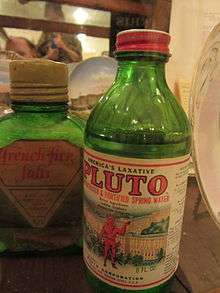Pluto Water

Pluto Water was a trademark for a strongly laxative natural water product which was very popular in the United States in the early 20th century. The water's high native content of mineral salts generally made it effective within one hour of ingestion, a fact the company emphasized in their promotional literature. Company advertisements stated the laxative was effective from a half-hour to two hours after ingestion. The water was an extremely popular product. In 1919, it took 450 railroad cars to transport the bottler’s output.[1]
Pluto Water was bottled at the French Lick Springs, in French Lick, Indiana, a location with natural mineral springs that was also the source of a competing product, Sprudel Water. It was advertised as "America's Laxative" with the slogan "When Nature Won't, PLUTO Will". The bottle and many advertisements featured an image of the devil, while its namesake was Pluto, the Roman god of the underworld; so named because of the water's origin underground.
The active ingredient of Pluto water was listed as sodium and magnesium sulfate, which are known as natural laxatives. The water also contains a number of other minerals, most notably lithium salts. Sale of Pluto water was halted in 1971, when lithium became a controlled substance.[1]
It was the main subject of the novel So Cold the River (2010) by Michael Koryta.[2]
-

"Pluto Spring", French Lick, 1903
-

Escape artist Harry Houdini (left) posing near Pluto Spring poster, c.1907
-

Newspaper advertisement, 1918
See also
References
- 1 2 Yaël Ksander, "," Moments of Indiana History (accessed May. 8, 2013)
- ↑ Janet Maslin, "A Hoosier Haunting: There’s Something in the Water That’s Very Strange," New York Times, June 30, 2010 (accessed Nov 13 2011)